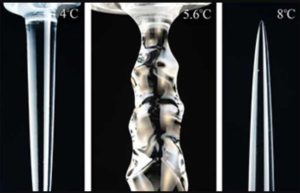Scientists discovered that ice formations are shaped by external forces

Mathematicians and physicists at New York University have discovered that ice formations are shaped by external forces, such as water temperature. The research may offer another means for gauging factors that cause ice to melt. The study is supported by the U.S. National Science Foundation.
“The shapes and patterning of ice are sensitive indicators of the environmental conditions at which it melted, allowing us to ‘read’ the shape to infer factors such as the ambient water temperature,” said Leif Ristroph, co-author of a paper published in Physical Review Letters.
“Our work helps us understand how melting induces unusual flow patterns that in turn affect melting, which is one of the many complexities affecting the ice on our planet,” added co-author Alexandra Zidovska. Other co-authors are Scott Weady and Josh Tong.
The researchers studied the melting of ice in water and how water temperature affects the eventual shapes and patterning of ice. They created ultra-pure ice, free of bubbles and other impurities. The team recorded the melting of ice submerged into water tanks in a cold room, similar to a walk-in refrigerator whose temperature is controlled and varied.
“We focused on the cold temperatures — 0 to 10 degrees Celsius — at which ice in natural waters typically melts, and we found a surprising variety of shapes that formed,” said Ristroph.
At very cold temperatures — those under about 5 degrees C — the pieces take on the shape of a spike or pinnacle pointing downward like an icicle, but perfectly smooth with no ripples.
For temperatures above approximately 7 C, the same basic shape forms, but upside down — a spike pointing upward. For in-between temperatures, the ice has wavy and rippled patterns melted into its surface. Similar patterns, called scallops, are found on icebergs and other ice surfaces in nature.
— NSF Public Affairs, researchnews@nsf.gov
